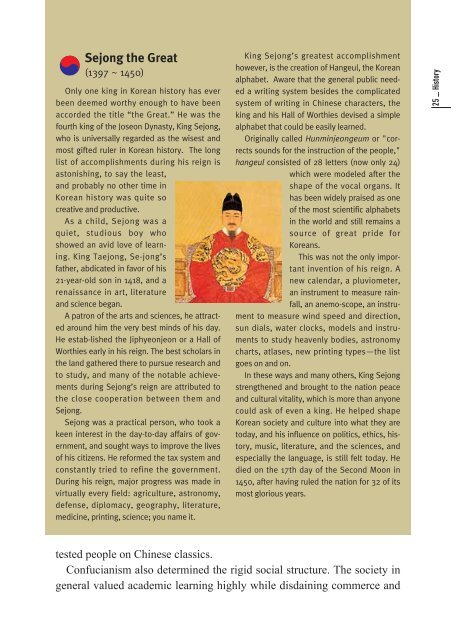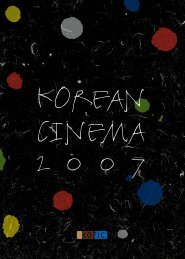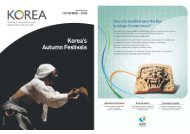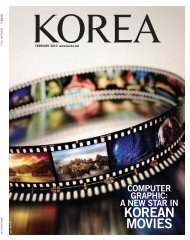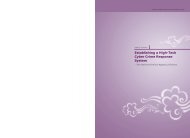HELLO from KOREA
Hello-Eng(3.3) - Korea.net
Hello-Eng(3.3) - Korea.net
- No tags were found...
Create successful ePaper yourself
Turn your PDF publications into a flip-book with our unique Google optimized e-Paper software.
Sejong the Great<br />
(1397 ~ 1450)<br />
Only one king in Korean history has ever<br />
been deemed worthy enough to have been<br />
accorded the title “the Great.” He was the<br />
fourth king of the Joseon Dynasty, King Sejong,<br />
who is universally regarded as the wisest and<br />
most gifted ruler in Korean history. The long<br />
list of accomplishments during his reign is<br />
astonishing, to say the least,<br />
and probably no other time in<br />
Korean history was quite so<br />
creative and productive.<br />
As a child, Sejong was a<br />
quiet, studious boy who<br />
showed an avid love of learning.<br />
King Taejong, Se-jong’s<br />
father, abdicated in favor of his<br />
21-year-old son in 1418, and a<br />
renaissance in art, literature<br />
and science began.<br />
A patron of the arts and sciences, he attracted<br />
around him the very best minds of his day.<br />
He estab-lished the Jiphyeonjeon or a Hall of<br />
Worthies early in his reign. The best scholars in<br />
the land gathered there to pursue research and<br />
to study, and many of the notable achievements<br />
during Sejong’s reign are attributed to<br />
the close cooperation between them and<br />
Sejong.<br />
Sejong was a practical person, who took a<br />
keen interest in the day-to-day affairs of government,<br />
and sought ways to improve the lives<br />
of his citizens. He reformed the tax system and<br />
constantly tried to refine the government.<br />
During his reign, major progress was made in<br />
virtually every field: agriculture, astronomy,<br />
defense, diplomacy, geography, literature,<br />
medicine, printing, science; you name it.<br />
King Sejong’s greatest accomplishment<br />
however, is the creation of Hangeul, the Korean<br />
alphabet. Aware that the general public needed<br />
a writing system besides the complicated<br />
system of writing in Chinese characters, the<br />
king and his Hall of Worthies devised a simple<br />
alphabet that could be easily learned.<br />
Originally called Hunminjeongeum or "corrects<br />
sounds for the instruction of the people,"<br />
hangeul consisted of 28 letters (now only 24)<br />
which were modeled after the<br />
shape of the vocal organs. It<br />
has been widely praised as one<br />
of the most scientific alphabets<br />
in the world and still remains a<br />
source of great pride for<br />
Koreans.<br />
This was not the only important<br />
invention of his reign. A<br />
new calendar, a pluviometer,<br />
an instrument to measure rainfall,<br />
an anemo-scope, an instrument<br />
to measure wind speed and direction,<br />
sun dials, water clocks, models and instruments<br />
to study heavenly bodies, astronomy<br />
charts, atlases, new printing types—the list<br />
goes on and on.<br />
In these ways and many others, King Sejong<br />
strengthened and brought to the nation peace<br />
and cultural vitality, which is more than anyone<br />
could ask of even a king. He helped shape<br />
Korean society and culture into what they are<br />
today, and his influence on politics, ethics, history,<br />
music, literature, and the sciences, and<br />
especially the language, is still felt today. He<br />
died on the 17th day of the Second Moon in<br />
1450, after having ruled the nation for 32 of its<br />
most glorious years.<br />
25 _ History<br />
tested people on Chinese classics.<br />
Confucianism also determined the rigid social structure. The society in<br />
general valued academic learning highly while disdaining commerce and


